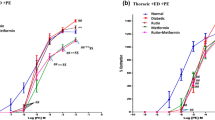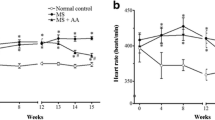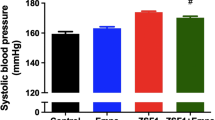Abstract
This study aims to scrutinize the potential protective effect of diosmin and crocin against cardio-vascular complications attributed to metabolic syndrome (MS). For 16 weeks, the rats were given 10% fructose in water and 3% salt in diet to induce MS over a 16-week period. At week 7 and for 10 weeks, diosmin (50 mg/kg, PO) or crocin (50 mg/kg, PO) was administered daily. Non-invasive blood pressure (BP) was recorded in conscious animals. Thoracic aorta (macro vessels) and kidney (micro vessels) concentration-response curves for phenylephrine (PE) and acetylcholine (ACh) were analyzed. Electrocardiogram (ECG) parameters were recorded. Blood glucose level, serum insulin level, troponin T, advanced glycation end products (AGEs), malondialdehyde (MDA), and tumor necrosis factor-α (TNF-α) were measured. In addition, histological examination of aorta and heart tissues was performed. Diosmin and crocin alleviated cardio-vascular complications associated with MS. This is manifested in improvement of systolic and diastolic BP and ECG parameters. They ameliorated MS-induced exaggerated contractility to PE and improved the impaired dilatation to Ach in macro and micro vasculature. Diosmin and crocin reduced the elevated serum levels of insulin, AGEs, TNF-α, and MDA and reversed MS-induced structural changes of aorta and cardiac tissues. Diosmin and crocin offset the cardiac changes and vascular impairment associated with MS via attenuation of oxidative stress and suppression of inflammation.







Similar content being viewed by others
Abbreviations
- AGEs:
-
Advanced glycation end products
- ANOVA:
-
analysis of variance
- CMS:
-
Crocin-treated metabolic syndrome
- DMS:
-
Diosmin-treated metabolic syndrome
- ELISA:
-
enzyme-linked immunosorbent assay
- ECG:
-
Electrocardiogram
- HOMA IR:
-
Homeostatic model assessment of insulin resistance
- MDA:
-
malondialdehyde
- MS:
-
metabolic syndrome
References
Ahmed S, Mundhe N, Borgohain M, Chowdhury L, Kwatra M, Bolshette N, Ahmed A, Lahkar M (2016) Diosmin modulates the NF-kB signal transduction pathways and downregulation of various oxidative stress markers in alloxan-induced diabetic nephropathy. Inflammation 39:1783–1797
Akhondzadeh S, Fallah-Pour H, Afkham K, Jamshidi AH, Khalighi-Cigaroudi F (2004) Comparison of Crocus sativus L. and imipramine in the treatment of mild to moderate depression: a pilot double-blind randomized trial [ISRCTN45683816]. BMC Complement Altern Med 4:12
Bacharova L, Krivosikova Z, Wsolova L, Gajdos M (2012) Alterations in the QRS complex in the offspring of patients with metabolic syndrome and diabetes mellitus: early evidence of cardiovascular pathology. J Electrocardiol 45:244–251
Batchvarov I (2010) One-year diosmin therapy (600 mg) in patients with chronic venous insufficiencyΓ_ôresults and analysis. J Biomed Clin Res 3
Baynes JW, Thorpe SR (1996) The role of oxidative stress in diabetic complications. Curr Opin Endocrinol Diabetes Obesy 3:277–284
Benavente-García O, Castillo J (2008) Update on uses and properties of Citrus flavonoids: new findings in anticancer, cardiovascular, and anti-inflammatory activity. J Agric Food Chem 56:6185–6205
Cao W, Cui J, Li S, Zhang D, Guo Y, Li Q, Luan Y, Liu X (2017) Crocetin restores diabetic endothelial progenitor cell dysfunction by enhancing NO bioavailability via regulation of PI3K/AKT-eNOS and ROS pathways. Life Sci 181:9–16
Chang-Liao WL, Chien CF, Lin LC, Tsai TH (2012) Isolation of gentiopicroside from Gentianae Radix and its pharmacokinetics on liver ischemia/reperfusion rats. J Ethnopharmacol 141:668–673
Chen J, Park HC, Patschan S, Brodsky SV, Gealikman O, Kuo MC, Li H, Addabbo F, Zhang F, Nasjletti A, Gross SS, Goligorsky MS (2007) Premature vascular senescence in metabolic syndrome: could it be prevented and reversed by a selenorganic antioxidant and peroxynitrite scavenger ebselen? Drug Discov Today 4:93–99
Chrysant SG (2015) Antihypertensive therapy causes erectile dysfunction. Curr Opin Cardiol 30:383–390
Dehghan F, Hajiaghaalipour F, Yusof A, Muniandy S, Hosseini SA, Heydari S, Salim LZA, Azarbayjani MA (2016) Saffron with resistance exercise improves diabetic parameters through the GLUT4/AMPK pathway in-vitro and in-vivo. Sci Rep 6:25139
Del Rio D, Stewart AJ, Pellegrini N (2005) A review of recent studies on malondialdehyde as toxic molecule and biological marker of oxidative stress. Nutr Metab Cardiovasc Dis 15:316–328
Di Mascio P, Murphy ME, Sies H (1991) Antioxidant defense systems: the role of carotenoids, tocopherols, and thiols. Am J Clin Nutr 53:194S–200S
Ebrahimi F, Aryaeian N, Pahlavani N, Fallah S, Moradi N, Heydari I (2019) The effect of saffron (Crocus sativus L.) supplementation on blood pressure, and renal and liver function in patients with type 2 diabetes mellitus: a double-blinded, randomized clinical trial. Avicenna J Phytomed
El-Bassossy HM, Shaltout HA (2015) Allopurinol alleviates hypertension and proteinuria in high fructose, high salt and high fat induced model of metabolic syndrome. Transl Res 165:621–630
El-Bassossy HM, Fahmy A, Badawy D (2011) Cinnamaldehyde protects from the hypertension associated with diabetes. Food Chem Toxicol 49:3007–3012
El-Bassossy HM, El-Fawal R, Fahmy A (2012) Arginase inhibition alleviates hypertension associated with diabetes: effect on endothelial dependent relaxation and NO production. Vasc Pharmacol 57:194–200
El-Fawal R, El Fayoumi HM, Mahmoud MF (2018) Diosmin and crocin alleviate nephropathy in metabolic syndrome rat model: effect on oxidative stress and low grade inflammation. Biomed Pharmacother 102:930–937
Elosta A, Ghous T, Ahmed N (2012) Natural products as anti-glycation agents: possible therapeutic potential for diabetic complications. Curr Diabetes Rev 8:92–108
Elsherbiny NM, Salama MF, Said E, El-Sherbiny M, Al-Gayyar MMH (2016) Crocin protects against doxorubicin-induced myocardial toxicity in rats through down-regulation of inflammatory and apoptic pathways. Chem Biol Interact 247:39–48
Feidantsis K, Apostolidou N, Galatou E, Lazou A (2016) Study of possible beneficial effect of crocin in an animal model of diabetes. Clin Nutr ESPEN 13:e65
Fukuzawa M, Satoh J, Qiang X, Miyaguchi S, Sakata Y, Nakazawa T, Ikehata F, Ohta S, Toyota T (1999) Inhibition of tumor necrosis factor-__ with anti-diabetic agents. Diabetes Res Clin Pract 43:147–154
Goh SY, Cooper ME (2008) The role of advanced glycation end products in progression and complications of diabetes. J Clin Endocrinol Metab 93:1143–1152
Gosslau A, Ho CT, Li S (2019) The role of rutin and diosmin, two citrus polyhydroxyflavones in disease prevention and treatment. J Food Bioact 5:43–56
Hassan NA, El-Bassossy HM, Mahmoud MF, Fahmy A (2014) Caffeic acid phenethyl ester, a 5-lipoxygenase enzyme inhibitor, alleviates diabetic atherosclerotic manifestations: effect on vascular reactivity and stiffness. Chem Biol Interact 213:28–36
Hassan NA, El Bassossy HM, Fahmy A, Mahmoud MF (2018) Limonin alleviates macro-and micro-vascular complications of metabolic syndrome in rats: a comparative study with azelnidipine. Phytomedicine 43:92–102
Heitzer T, Schlinzig T, Krohn K, Meinertz T, Münzel T (2001) Endothelial dysfunction, oxidative stress, and risk of cardiovascular events in patients with coronary artery disease. Circulation 104:2673–2678
Hotamisligil GS, Peraldi P, Budavari A, Ellis R, White MF, Spiegelman BM (1996) IRS-1-mediated inhibition of insulin receptor tyrosine kinase activity in TNF-__-and obesity-induced insulin resistance. Science 271:665–670
Huang PL (2009) A comprehensive definition for metabolic syndrome. Dis Model Mech 2:231–237
Isomaa BO, Almgren P, Tuomi T, Forsén B, Lahti K, Nissen M, Taskinen MR, Groop L (2001) Cardiovascular morbidity and mortality associated with the metabolic syndrome. Diabetes Care 24:683–689
Jay D, Hitomi H, Griendling KK (2006) Oxidative stress and diabetic cardiovascular complications. Free Radic Biol Med 40:183–192
Kamata K, Hosokawa M, Matsumoto T, Kobayashi T (2006) Acetylcholine-induced vasodilation in the perfused kidney of the streptozotocin-induced diabetic rat: role of prostacyclin. J Smooth Muscle Res 42:159–170
Kubota K, Kubota N, Pearce GL, Inman WHW (1996) ACE-inhibitor-induced cough, an adverse drug reaction unrecognised for several years: studies in prescription-event monitoring. Eur J Clin Pharmacol 49:431–437
Liu N, Yang Y, Mo S, Liao J, Jin J (2005) Calcium antagonistic effects of Chinese crude drugs: preliminary investigation and evaluation by 45Ca. Appl Radiat Isot 63:151–155
Mancini A, Serrano-Díaz J, Nava E, D’Alessandro AM, Alonso GL, Carmona M, Llorens S (2014) Crocetin, a carotenoid derived from saffron (Crocus sativus L.), improves acetylcholine-induced vascular relaxation in hypertension. J Vasc Res 51:393–404
Matthews DR, Hosker JP, Rudenski AS, Naylor BA, Treacher DF, Turner RC (1985) Homeostasis model assessment: insulin resistance and __-cell function from fasting plasma glucose and insulin concentrations in man. Diabetologia 28:412–419
Messerli FH (2002) Vasodilatory edema: a common side effect of antihypertensive therapy. Curr Cardiol Rep 4:479–482
Moreno V, Hernández-Romero D, Vilchez JA, García-Honrubia A, Cambronero F, Casas T, González J, Martínez P, Climent V, de la Morena G (2010) Serum levels of high-sensitivity troponin T: a novel marker for cardiac remodeling in hypertrophic cardiomyopathy. J Card Fail 16:950–956
Mori T, Ishigai Y, Fukuzawa A, Chiba K, Shibano T (1995) Pharmacological profile of semotiadil fumarate, a novel calcium antagonist, in rat experimental angina model. Br J Pharmacol 116:1668–1672
Munir KM, Chandrasekaran S, Gao F, Quon MJ (2013) Mechanisms for food polyphenols to ameliorate insulin resistance and endothelial dysfunction: therapeutic implications for diabetes and its cardiovascular complications. Am J Physiol Endocrinol Metab 305:E679–E686
Münzel T, Gori T, Bruno RM, Taddei S (2010) Is oxidative stress a therapeutic target in cardiovascular disease? Eur Heart J 31:2741–2748
Nava E (2013) Hypertension in metabolic syndrome: vascular pathophysiology. Int J Hypertens 2013
Nikbakht-Jam I, Khademi M, Nosrati M, Eslami S, Foroutan-Tanha M, Sahebkar A, Tavalaie S, Ghayour-Mobarhan M, Ferns GAA, Hadizadeh F, Tabassi SAS, Mohajeri SA, Emamian M (2016) Effect of crocin extracted from saffron on pro-oxidantΓ_ôanti-oxidant balance in subjects with metabolic syndrome: a randomized, placebo-controlled clinical trial. Eur J Integr Med 8:307–312
Omland T, de Lemos JA, Sabatine MS, Christophi CA, Rice MM, Jablonski KA, Tjora S, Domanski MJ, Gersh BJ, Rouleau JL (2009) A sensitive cardiac troponin T assay in stable coronary artery disease. N Engl J Med 361:2538–2547
Oyenihi AB, Brooks NL, Oguntibeju OO, Aboua G (2014) Antioxidant-rich natural products and diabetes mellitus. In: Antioxidant-antidiabetic agents and human health. IntechOpen
Palatini P, Julius S (2004) Elevated heart rate: a major risk factor for cardiovascular disease. Clin Exp Hypertens 26:637–644
Paykel ES, Fleminger RUTH, Watson JP (1982) Psychiatric side effects of antihypertensive drugs other than reserpine. J Clin Psychopharmacol 2:14–39
Pérez-Torres I, El Hafidi M, Pavón N, Infante O, Avila-Casado MC, Baños G (2010) Effect of gonadectomy on the metabolism of arachidonic acid in isolated kidney of a rat model of metabolic syndrome. Metab Clin Exp 59:414–423
Potenza MA, Marasciulo FL, Chieppa DM, Brigiani GS, Formoso G, Quon MJ, Montagnani M (2005) Insulin resistance in spontaneously hypertensive rats is associated with endothelial dysfunction characterized by imbalance between NO and ET-1 production. Am J Phys Heart Circ Phys 289:H813–H822
Queenthy SS, John B (2013) Diosmin exhibits anti-hyperlipidemic effects in isoproterenol induced myocardial infarcted rats. Eur J Pharmacol 718:213–218
Ross R (1999) AtherosclerosisΓ_¤an inflammatory disease. N Engl J Med 340:115–126
Sachdeva J, Tanwar V, Golechha M, Siddiqui KM, Nag TC, Ray R, Kumari S, Arya DS (2012) Crocus sativus L.(saffron) attenuates isoproterenol-induced myocardial injury via preserving cardiac functions and strengthening antioxidant defense system. Exp Toxicol Pathol 64:557–564
Sampathkumar R, Balasubramanyam M, Rema M, Premanand C, Mohan V (2005) A novel advanced glycation index and its association with diabetes and microangiopathy. Metab Clin Exp 54:1002–1007
Senthamizhselvan O, Manivannan J, Silambarasan T, Raja B (2014) Diosmin pretreatment improves cardiac function and suppresses oxidative stress in rat heart after ischemia/reperfusion. Eur J Pharmacol 736:131–137
Sepahi S, Mohajeri SA, Hosseini SM, Khodaverdi E, Shoeibi N, Namdari M, Tabassi SAS (2018) Effects of Crocin on diabetic maculopathy: a placebo-controlled randomized clinical trial. Am J Ophthalmol 190:89–98
Shabani S, Mirshekar MA (2018) Diosmin is neuroprotective in a rat model of scopolamine-induced cognitive impairment. Biomed Pharmacother 108:1376–1383
Shahmansouri N, Farokhnia M, Abbasi SH, Kassaian SE, Tafti AAN, Gougol A, Yekehtaz H, Forghani S, Mahmoodian M, Saroukhani S (2014) A randomized, double-blind, clinical trial comparing the efficacy and safety of Crocus sativus L. with fluoxetine for improving mild to moderate depression in post percutaneous coronary intervention patients. J Affect Disord 155:216–222
Shalkami AS, Hassan MIA, Bakr AG (2018) Anti-inflammatory, antioxidant and anti-apoptotic activity of diosmin in acetic acid-induced ulcerative colitis. Hum Exp Toxicol 37:78–86
Sheng L, Qian Z, Zheng S, Xi L (2006) Mechanism of hypolipidemic effect of crocin in rats: crocin inhibits pancreatic lipase. Eur J Pharmacol 543:116–122
Shirali S, Zahra Bathaie S, Nakhjavani M (2013) Effect of crocin on the insulin resistance and lipid profile of streptozotocinΓ__induced diabetic rats. Phytother Res 27:1042–1047
Silambarasan T, Raja B (2012) Diosmin, a bioflavonoid reverses alterations in blood pressure, nitric oxide, lipid peroxides and antioxidant status in DOCA-salt induced hypertensive rats. Eur J Pharmacol 679:81–89
Tack CJ, Smits P, Willemsen JJ, Lenders JW, Thien T, Lutterman JA (1996) Effects of insulin on vascular tone and sympathetic nervous system in NIDDM. Diabetes 45:15–22
Wang H, Feng Y, Behl M, Lendlein A, Zhao H, Xiao R, Lu J, Zhang L, Guo J (2011) Hemocompatible polyurethane/gelatin-heparin nanofibrous scaffolds formed by a bi-layer electrospinning technique as potential artificial blood vessels. Front Chem Sci Eng 5:392–400
Yamagishi S, Maeda S, Matsui T, Ueda S, Fukami K, Okuda S (2012) Role of advanced glycation end products (AGEs) and oxidative stress in vascular complications in diabetes. Biochim Biophys Acta Gen Subj 1820:663–671
Zakaria EM, El-Bassossy HM, El-Maraghy NN, Ahmed AF, Ali AA (2016) PARP-1 inhibition alleviates diabetic cardiac complications in experimental animals. Eur J Pharmacol 791:444–454
Author information
Authors and Affiliations
Contributions
RE contributed to the experimental design, performed the experiments, conceived the study, oversaw all data collection and analysis, and drafted the manuscript. HF contributed to the experimental design and manuscript preparation. MF contributed to experimental design, data analysis and interpretation, and manuscript preparation. All authors have read and approved the final manuscript.
This research did not receive any specific grant from funding agencies in the public, commercial, or not-for-profit sectors.
Corresponding author
Ethics declarations
Conflict of interest
The authors declare that they have no conflict of interest.
Additional information
Publisher’s note
Springer Nature remains neutral with regard to jurisdictional claims in published maps and institutional affiliations.
Rights and permissions
About this article
Cite this article
El-Fawal, R., El Fayoumi, H.M. & Mahmoud, M.F. Effects of diosmin and crocin on metabolic syndrome-associated cardio-vascular complications in rats. Naunyn-Schmiedeberg's Arch Pharmacol 392, 1523–1536 (2019). https://doi.org/10.1007/s00210-019-01700-8
Received:
Accepted:
Published:
Issue Date:
DOI: https://doi.org/10.1007/s00210-019-01700-8




